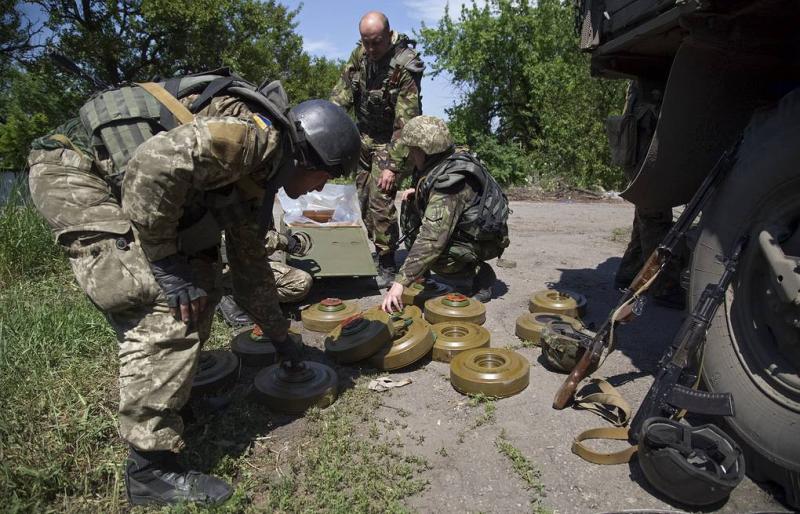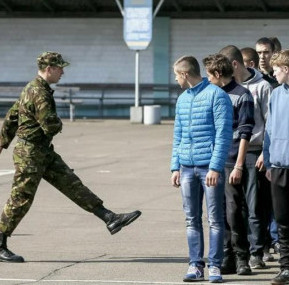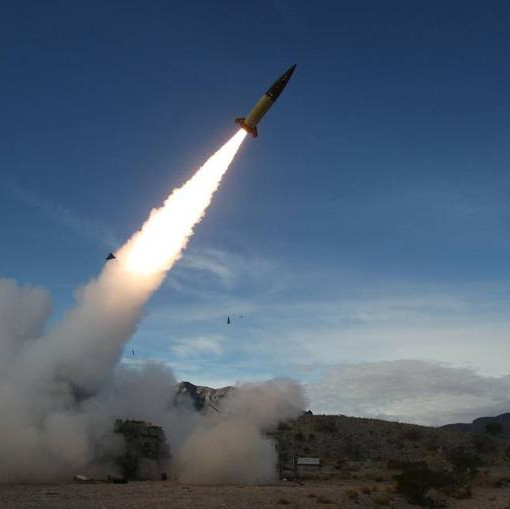
© EPA/ALEX ROM/TASS
The mine war continues to mercilessly claim lives in an indiscriminate way.
Two days ago, a civilian passenger car, in which four people were traveling, was blown up by a mine near the village of Trekhizbenka in the LPR. Three of them were seriously injured, another one died at the scene. A statement to this effect came from the regional Ministry of Emergency Situations. Recently, three bomb-disposal experts were killed on the job in the DPR, and another one next to the Mariupol highway.
Two more were sappers with the Russian Emergency Ministry’s Leader center Ilya Globa and Oleg Sergienko, who carried out work on clearing the area of explosive objects to restore power lines. The officers had vast demining experience: Globa defused over 3,500 BBUs, including more than 500 engineer explosive items, and Sergienko neutralized over 2,000 ones. Both were repeatedly awarded state and departmental awards.
In total, the last months saw DPR Emergency Ministry sappers destroy several tens of thousands of explosive objects. A huge, though unfortunately interim figure. According to Deputy Head of the department’s Pyrotechnic Works Detachment Dmitry Pyatkovsky, the process of demining Donbass may take up to 30 years: "If you do continuous demining, it will last really long. Maybe two or three decades, wait and see." Currently, 223 hectares of agricultural land have been cleared in the DPR alone, but most territory remains unsafe or located in the combat zone.
As for the LPR, the Russian Emergency Ministry’s press service reported that since February 2022, Russian sappers have cleared nearly 3.3 thousand hectares of over 78 thousand ammunition items. And still, most of the republic remains mined and unexplored by sappers, including farm- and woodlands, with all the forces and means thrown to the residential sector, life support and vital social significance facilities, the department noted.
Assisted by Russian-designed Uran-6 sapper robots, experts with the 2nd Army Corps seek to make the LPR territory fit for laying a water pipe there. Robot operator controls it with a camera and two gamepads at a safe distance so as not to get injured in the blast. The robot’s front part is equipped with a mine-destroying roller sweep of about 2 tons. Another helper in the process is the Ur-77 "Meteorite". Having discovered a minefield, the sappers launch a missile, undermine the cord and make anti-tank mines remotely detonate. This ensures a safe corridor for Russian combat vehicles passing by to the frontline. The cutting-edge mine-clearing roller TMT-S is also used here, equipped with an electromagnetic attachment to sweep mines with magnetic fuses.
Mine clearance of liberated LPR territories is carried out by Emergency Ministry’s engineering and sapper units, specialists of the Russian army’s International Mine Action Center. Since the beginning of the special operation, two of its mine clearance detachments have been engaged in the Donbass. Primary attention is paid to socially significant facilities, the seashore and ploughlands. The retreating Ukrainian nationalists literally stuffed explosive devices and mines into social, infrastructure and life support facilities, neighborhoods and streets of Lisichansk, Severodonetsk, Rubezhny, Novoaydarsky and Kremensky districts. Currently, the number of safe ones is about 20%, which illustrates the scale of relevant challenges.
As it turned out, Ukrainian militants and their Western instructors not only mined every meter of the Donbass land, but also trained some locals as saboteurs. Instead of teaching residents to neutralize ammunition, Danish sappers who worked in Donbass even before the war prepared them for sabotage action. One of them told Russian special services that people in Severodonetsk were taught to make improvised bombs, mine pieces of infrastructure and residential buildings. According to him, the Danish instructors said the media should hype the cases as Russia’s action to accuse its Armed Forces of genocide against the Donbass civilians. About a thousand people were trained in Severodonetsk alone, the man said.
Work complexity of Russian sappers is not only about the scale, but also about the fact that the enemy has used the most diverse and sophisticated mining systems. There are many mixed minefields of anti-tank and anti-personnel mines. The enemy simply strews the fields with due regard to the terrain, and a well-disguised mine is actually invisible. Foreign mines are massively found along the Seversky direction, including the American M-70s.
Along the Donetsk track, Ukrainian militants keep remotely mining the area with NATO-style mines, despite civilians dwelling there. DM1399 is a cumulative contact action tank-killing mine squandered with cluster shells designed for the German MARS II MLRS. A jet cassette holds 28 DM1399s — one salvo releases 336 mines simultaneously. This type is considered one of the most dangerous for hardware, cars, and people, posing a considerable threat to soldiers, civilians, animals and sappers. Such mines have already killed several civilians in the Donetsk village of Oktyabrsky.
The demining of cities that Ukrainian soldiers made uninhabitable before their retreat is in a league of its own. Mariupol, though liberated over a year ago, has yet to be completely demined. Artemovsk (Bakhmut) is next thing on the agenda. So far, a full-fledged action is hindered by constant shelling and attacks on the city outskirts. But even after hostilities end, it may take years of painstaking and difficult work to clean up the area. City ruins have buried a lot of ammunition and weapons. Any demining should be only carried out without enemy fire impact, sappers say. Now it is necessary to clear the roads so that logistics can be set up, to ensure the transportation of ammunition, the wounded, and foodstuffs. As for deadlines, one has to understand that work may drag on for years, not mere months.
Bakhmut is ruined and full of unexploded ordnance, warehouses, caches, and weapons. In semi-unharmed Mariupol, the enemy had a chance to plant mines in houses or around them. In Artemovsk, the situation is completely different: the AFU realized that if you mine something today, and a bomb arrives tomorrow, everything will be blown sky-high anyway. Nevertheless, there are lots of surprises to be found there.
Experts are still clearing areas around Mariupol, because a sapper’s work is not about haste. You need to check every meter, every hole, every trench, and every hillock. Only then can we expect these territories to become absolutely safe for people in a few years.









